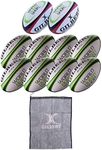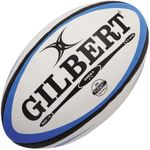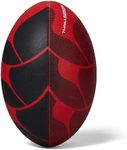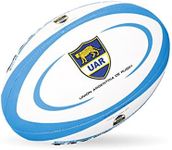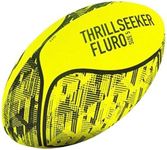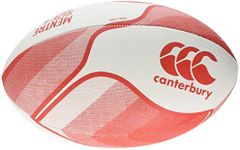Buying Guide for the Best Rugby Balls
Choosing the right rugby ball is crucial for both performance and enjoyment of the game. Whether you're a beginner, an amateur player, or a professional, the right ball can make a significant difference. When selecting a rugby ball, consider factors such as size, material, grip, and durability. Understanding these key specifications will help you make an informed decision that suits your playing style and needs.SizeRugby balls come in different sizes, typically ranging from size 3 to size 5. Size 3 is generally for younger players (under 9 years old), size 4 is for youth players (ages 10-14), and size 5 is the standard size for adults and professional play. Choosing the right size is important for proper handling and skill development. If you're buying for a child, make sure to get the appropriate size to help them learn the game effectively.
MaterialRugby balls are made from various materials, including synthetic rubber and leather. Synthetic rubber balls are more common and are suitable for all weather conditions, making them ideal for training and matches. Leather balls offer a traditional feel and are often used in professional games, but they can be more expensive and require more maintenance. Consider where and how often you'll be playing when choosing the material.
GripThe grip of a rugby ball is determined by the texture and pattern on its surface. A good grip is essential for handling the ball, especially in wet conditions. Balls with a pronounced grip pattern are ideal for beginners and training, as they are easier to catch and hold. Professional players might prefer a ball with a slightly smoother surface for better control during passes and kicks. Think about your level of play and the typical playing conditions when selecting the grip.
DurabilityDurability is a key factor, especially if you plan to use the ball frequently. Training balls are designed to withstand regular use and rough conditions, while match balls are built for performance and may not be as durable. Look for balls with reinforced stitching and high-quality materials if you need something that will last. If you're a casual player, a standard training ball should suffice, but serious players might want to invest in a more durable option.
Bladder TypeThe bladder inside the rugby ball affects its air retention and shape. Latex bladders offer a softer feel and better performance but may require more frequent inflation. Synthetic bladders, on the other hand, provide better air retention and are more durable, making them suitable for training and regular use. Consider how often you're willing to inflate the ball and your preference for feel and performance when choosing the bladder type.

